QUAKER CAMPUS
Uptown Rallies for Ceasefire



Time is up and the results are in!
Some Whittier residents are celebrating Easter a little differently this year.
On Sunday, March 31, amidst a busy Easter Sunday crowd, over 70 local citizens gathered at Central Park in Uptown Whittier to participate in a Free Palestine Rally and march through Uptown. The event was put together by the Pico-Whittier Alliance for Liberation and Peace, a local organization that has recently been advocating for neighboring cities such as Pico Rivera and Montebello to call on Israel for a ceasefire in Gaza.
The event took place one week prior to the Whittier City elections, an event that has also recieved public criticim from residents. See "Whittier Elections Met With Backlash," on the Quaker Campus Medium for more information.
The organizers of the recent
"We are here because we recognize Whittier is a conservative city and there has been no action in this part of Los Angeles County."
-Activist Lauren Ruiz
The public was made aware of the event via an Instagram post which read “Rally for Palestine: Genocidal values do not represent Whittier,” which encouraged participants to wear masks and bring signs and megaphones.
rally criticized President Biden for sending, “our tax dollars overseas to fund genocide.” Tensions were expected to be high, as the group recognized the religious observance of Easter in Uptown, given the number of churches.
For the safety of those in attendance as well as for the public, organizers encouraged protesters to refrain from using the word “Zionist,” and to pass flyers instead of en-
During the rally, speakers of the Pico-Whittier Alliance delivered speeches that criticized Whittier residents and Whittier City Council members on their failure to call for a ceasefire. A member of the movement, Lauren Ruiz, stated, “We are here because we recognize Whittier as a conservative city and there has been no action in this part of Los Angeles County. We are asking the City Council to call a ceasefire as well.”

gaging in discourse. The flyers that were passed out read “Free Palestine. Ceasefire Now. End the occupation,” followed by information concerning the conditions in Gaza which read, “No food, water, baby formula, or medicine.”
Some Whittier students were also in attendance, including third -year student and Co-Chair of the Whittier Student-Worker Alliance (WSWA), Aidan Moore, who brought umbrellas since storm clouds were threatening the crowd. Once additional signs and umbrellas were distributed, the group began their march with Pico-Whittier Alliance organizers at the front along with two people with a large marching drum and snare drum.
A variety of chants rang out, including, “Whittier, Whittier, you can’t hide! You’re committing genocide!” and “From Palestine to Mexico, all these walls have got to go!” as the group walked, waving Palestinian flags and distributing flyers. As they approached the corner of Hadley St. and Greenleaf Ave., a crowd of people could be seen gathered in front of Freedom City Church.
The march crossed the street and the crowds clashed, withchurch-goers chanting, “Jesus, Jesus, Jesus,” holding their bibles high. Almost immediately, the protestors began to march towards City Hall.
Before reaching City Hall, the group stopped in front of the Starbucks in Uptown, as speakers claimed that the company funds the Israeli Defense Force and condemned consumers for supporting them. Customers were seen leaving the coffee shop, as the group waved their flags and signs in front of the windows. The group then reached City Hall. Those who stayed rejoined at Central Park to enjoy sandwiches provided by the Pico-Whittier Alliance and listened to statements that urged Whittier citizens to vote in the city elections.
In their final remarks, organizers urged locals to hold their elected officials accountable and be the voice of the Palestinian people, stating, “We can no longer ignore what is happening. Viva, viva, Palestina!”
On April 4, the results of this year's Big Poet Give were released. The ninth annual Big Poet Give, held March 27, was a success for the College, as they raised $242,757, which is $99,258 more than what the College raised last year. This year also saw an increase in the number of donors, from 191 to 447, with the top three donor states being California, Washington, and Oregon.
Aside from the money donated directly to the College, Whittier was able to match seven funds, which together brought in $108,568. These funds included the $15,000 President’s Challenge, and the $20,000 Stretch Challenge, which was announced earlier this year in collaboration with the fundraising initiative Whittier Now! Proceeds from this challenge are directed to Whittier Now!, which promotes personalized education, the liberal arts, the College’s “welcoming setting,” mission and values, social mobility, and “Poet Pride,” to name a few.
The other matches in this donation initiative were Gifts from Faculty and Staff Match Challenge, which aimed for $5,000 and met that goal by receiving a $5,000 donation from Schoolsfirst Credit Union, and $12,000 from the Whittier College Black Alumni Association (WCBAA) initiative. About $20,000 was raised by past and present College parents through the $10,000 Current and Past Poet Parents Match Fund. And finally, the $2,500 Emergency School Book Match Challenge fell short of its desired goal at $1,968 raised. Several of the donors for the match challenges were College alum.
In regards to meeting the College's fundraising goal, Whittier Now! fundraising initiative,
as announced on Nov. 16, 2023, is to raise $20 million within the next five years (2028), and with the success of this year’s donations the College predicts they are right on-track.
Within the last few years, the College has experienced around a 200 student decrease in enrollment, partially due to the removal of men’s lacrosse, men and women’s golf, and Poet football in November 2022.
As reflected by state numbers, lack of enrollment can affect school finances which prompted the closure of multiple private Catholic institutions including La Reina in Ventura County, followed by St. Agnes and St. Teresa Avila in Los Angeles County. The College’s own financial records for the last fiscal year were published last month. For more information, see “Finances Reflect Last Year" on page two.
Although the fundraiser is over, Poets and donors are still able to support the College as the website provides an active link at givingday.whittier.edu.
The College also thanked and acknowledged those who went "Big" and participated in the fundraiser, stating, “Thank you, Poet family! You make the Big Poet Give possible. Your enthusiastic support of the Big Poet Give is a valuable investment in our students’ success.” The updated donor wall is available for those who did not mind sharing their name and gift amount. The option to remain anonymous is available as well.
In the meantime, the College urges the community to invest in the Whittier Fund through the Whittier Now! initiative, stating, "With your support for the Whittier Fund—which invests in every area of the College for sustained growth—we are able to safeguard the services that are so essential to our student experience, including the faculty and staff who create it."

 Sarah Licon NEWS EDITOR
Sarah Licon NEWS EDITOR
The financial records for the 2023 fiscal year have been released after a three-month delay, as the statement, which is released annually in late November to early December of each new year, was released just last month on March 18. The Quaker Campus has been reaching out since late November and were told by the College the records would be released in December.
The statement, which is accessible through the Business Office website, reflects the “Financial position of the College as of June 30, 2023, and 2022, and the related statements, activities, and cash flows for the years ended in accordance with US-generally-accepted accounting principles.”
Because of this, the numbers do not reflect the current financial position of the College and do not include the revenue earned by the Whittier Now! fundraising initiative, nor the tuition increase, which is set to begin in Fall 2024.
As expected, the statements showcased a decrease in revenue as opposed to the 2022 fiscal year. Tuition income decreased with a $1,791,879 difference in revenue between 2023 and 2022—with total revenue including tuition accumulating to $49,437,130 in 2022 and $46,283,547 in 2023. Revenue refers to student tuition fees (excluding $30,224,423 in financial aid), private gifts, grants and pledg-
es, government grants, investment income, and income from auxiliary enterprises. According to the statement, “auxiliary enterprises consist of room and board, bookstore revenues, and conference fees.”
Aside from the decrease in each category, the numbers of private gifts, pledges, and government grants were significantly lower.
Government grants accumulated to $5,670,043 in the 2022 fiscal report but decreased to $555,693 in 2023, while the College earned $5,576,980 in private gifts and grants in 2022, which barreled down to $4,027,722 in 2023. To quell this problem, the College introduced the fundraising initiative, Whittier Now!, which raised $1 million in 2023. The annual Big Poet Give, which wrapped up on March 27, received a total donation of $242,757. See "Big Poet Give: Gives Back!" on page one. This is more than last year’s Big Poet Give, and will be reflected in the statement of the 2024 fiscal year.
While most assets remained stable, highly liquid assets or cash equivalents decreased from 2022, accumulating to $7,097,416. The classifications of net assets include cash and cash equivalents, shortterm investments, accounts and loans receivable, prepaid expenses and other unnamed assets, pledges receivable, long-term investments, and plant facilities.
However, despite the differences in the College's assets, expenses increased. Among these
expenses are worker compensation, services and supplies, and depreciation expenses. Depreciation refers to a decrease in the value of assets in relation to what the College considers assets. Faculty compensation was higher in this report, at $32,902, 245.
Expenses in 2023 increased by roughly $407,000, despite a decrease in revenue. As of June 2023, the College spent $61,135,528 in expenses, although it received an accumulative income of $46,283,547. This means that as of June 2023, the College has a $14,851,981 deficit. This is less than 2022, as the financial deficit was $7,538,495, which could be attributed to the College receiving a total revenue of $49,437,130 and spending a smaller amount of $56,975,625.
For this year, the expenses have gone up by $4,159,903, with faculty compensation at $32,902,245 as opposed to $31,912, 674 in 2022.
Faculty were recently promised a 2.5 percent increase in pay, which is yet to be reflected in next year’s financial report. See “Faculty Advocate for Increased Pay" via the Quaker Campus Medium page for more information.
The financial numbers for the 2024 fiscal year are expected to be collected in June of this year, with no official publication date.
The financial statements could be accessed by going to www.whittier.edu/businessoffice/financials, and includes a list of the financial statements since 2015
sTAFF WriTErs
EsTAsiA mcGloTHlin
PiPEr GUinn
AllArA BAkEr
PAiGE mEyEr-drAFFEn
oliViA nUnEz
cArA dElos rEyEs
PriscillA coronA
coPy EdiTors
EmmA GAlVAn
AsHlEy sEGEr
sArA mArTinEz
PHoToGrAPHErs

sPorTs EdiTor
lUcy cAmPBEll
cAmPUs liFE
nUnE PAPikyAn
JAcoB PErEz
cArToonisT
nEmi
AsTroloGy
ViA
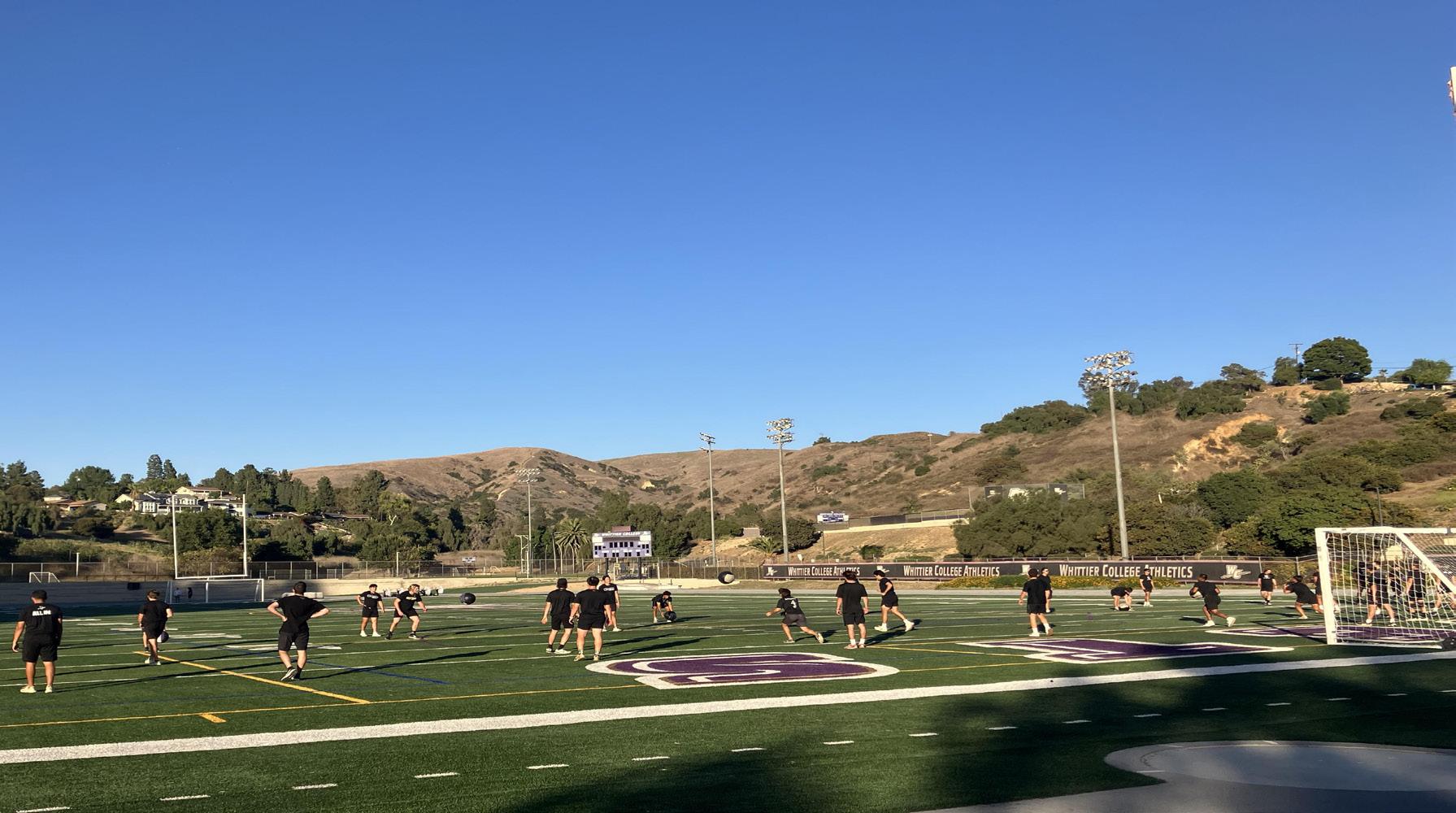 Emma Galvan
COPY EDITOR
Emma Galvan
COPY EDITOR
It has been over a year and a half since Whittier College announced the discontinuation of multiple sports programs.
On Nov 12., during the Fall 2022 semester, Whittier College announced via the College website that they would be cancelling: football, men’s lacrosse, and both men’s and women’s golf. But now, one year later, this begs the questions: where exactly did the funds go, and did cutting the sports generate any funding for the College?
According to former Board of Trustees Chair Miguel Santana, and
campus “spent roughly half a million dollars on the football program each year.” Also, because of the lack of attendance for college games, alongside a growing concern surrounding contact sports, which football and lacrosse fall under. As stated in the announcement, contact sports can result in chronic traumatic enceph-
alopathy, or CTE. The College claimed that they did not want to take the risk and would rather cut the sports to avoid players developing CTE. When the announcement was published, the Board of Trustees assured students that the money from the sports would not go to waste. According to the Board, the money from the discontinued sports would be distributed to the
"We are reinvesting our resources and efforts in programs that will impact even more of our students. We will continue to be open to other innovative developments that meet our students' needs."
-Former Board of Trustees Chair Miguel Santana
18 remaining sports on campus, along with contributing more support to academic, health and wellness, and recreational programs. When explaining the concept of distribution, the former chair Miguel Santana claimed that “we are reinvesting our resources and efforts in programs that will impact even more of our students. We will continue to be open to other innovative developments that meet our students’ needs.”
Now the effect of the cancellation is still lingering in conversations. Although the exact health and wellness programs were not disclosed, the College’s press liason, Gillian Frew, unveiled that the budget primarily goes towards academic programs, as it is customary whenever the College has to make any cuts in departments.
In regards to the multiple sports programs' cancellations, Frew states, “Unfortunately," states Frew, "In the case of the athletic programs that were discontinued under the previous Whittier leadership, the loss of tuition dollars from student athletes who transferred from Whittier was far greater than any savings realized.” Frew’s disclosure about the decline in student athletes attending Whittier is tied to a promise made by the College to keep financial aid assistance as confirmed in the announcement last November.
Student atheletes are not eligible to recieve financial aid for
their involvement in the College's athletic programs. Due to this, the elimination of any sports programs does not affect the aid their student athletes recieve. However, some student athletes expressed that taking away their ability to participate in their sport was a struggle that they could not overcome, and as a result, most student athletes from the discontinued sports either graduated or transferred to a different sport, institution, or activity. The cut in costs for the academic programs could help expand and recover the decreased student population, another possible solution to the overall problem.
However, if these specific sports teams were not discontinued, Frew believes more money would have been spent on the departments. “Had the now discontinued programs been retained, the College leadership [would have known] that additional investment in some of those sports would have been required in order for them to achieve success.”
Recently, an online petition was formed to reinstate men's lacrosse in club form, the only way in which these sports could be revived, according to the Board of Trustees. See "Whittier College Reinstating Lacrosse?" on page seven for information. However, according to Frew, undisclosed academic programs will continue to benefit from these fundings, allowing for more opportunities.
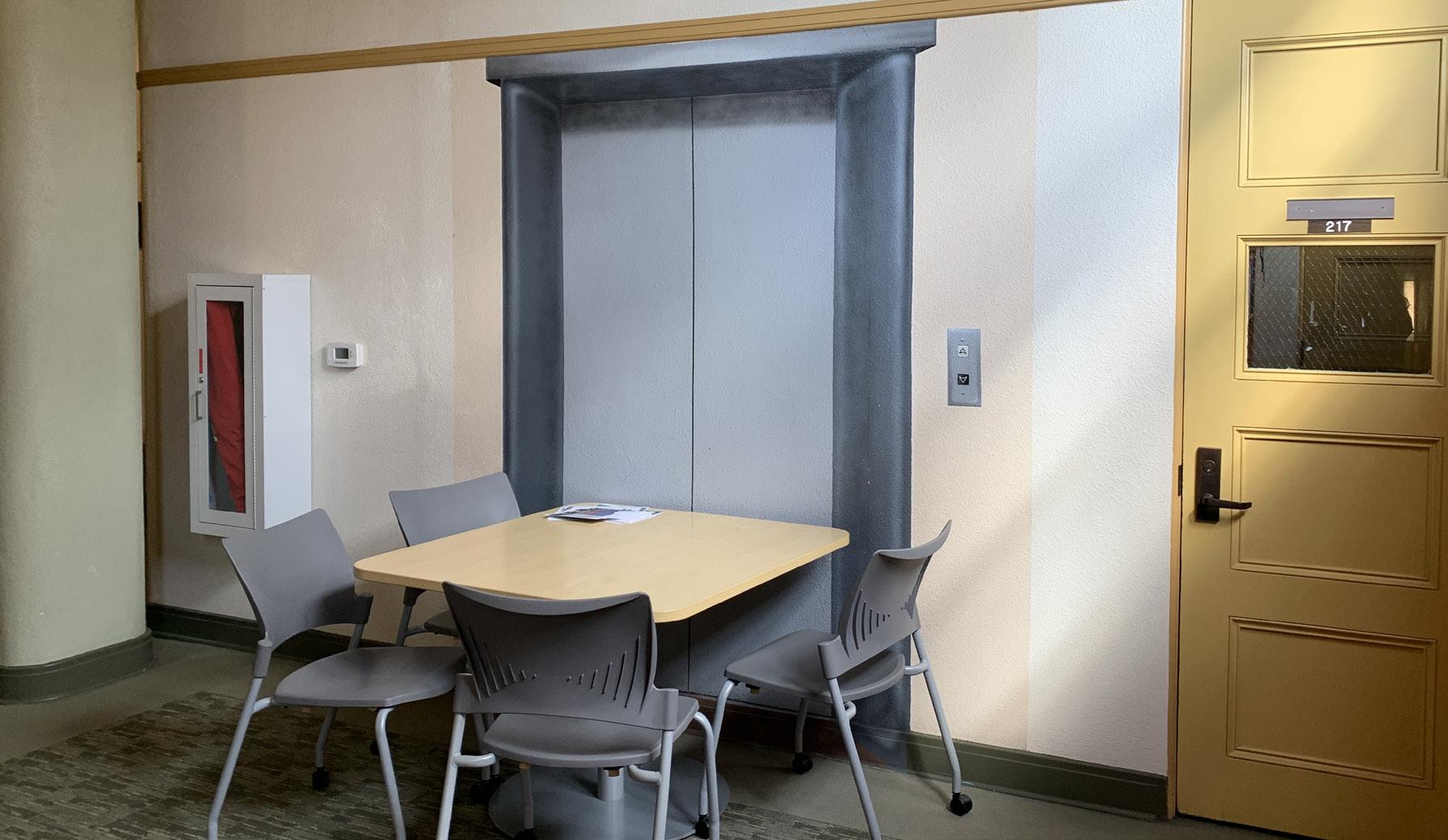
The conversation surrounding Whittier College accessibility remains.
Last month marked Disability Awareness Month, which raised the question of how Whittier accommodates disabled students in regards to campus accessibility.
According to third-year student Luka Kenderian, who utilizes disability services, “Whittier College is not well known for its disability-friendly campus. Many students find themselves having to miss a class or not being able to take a course altogether due to the
campus not meeting their needs for accommodations." Other students expressed frustration with the Science and Learning Center’s (SLC) single elevator, after continually receiving emails from the school that it is not working. The number of times it occurs, according to Kenderian, has been a cause for concern for those with mobility aids trying to get to classes that are not on the first or second floors.
According to the College Wheelchair Accessibility map, the College is comprised of buildings labeled as fully accessible, partially accessible with single-floor access, and not accessible at all. Per this map, there are a few buildings on
campus that are considered to have no accessibility, excluding buildings with only single-floor access. This includes buildings mainly used for classes such as Wardman Hall with its steps and no ramp, and Platner Hall, which is accessible through stairs at the main entrance. According to Student Accessibility Services (SAS), Whittier College is also actively working on combatting these obstacles and creating a more accessible campus through implementing more ramps.
Out of the eight dorm buildings, the only one not accessible to those with mobility aids is Wanberg Residence Hall.
Despite the College’s inacces-
“Whittier College isn’t well known for its disability-friendly campus. Many students find themselves having to miss a class or not being able to take a course altogether due to the campus not meeting their needs for accommodations."
-Third-year Luka Kenderiansible buildings, according to the Wheelchair Accessibility map, there are eight buildings that are partially and fully accessible to students with mobility aids, as they either have an elevator or a single floor. Among these are the Campus Inn and the Spot, as the Campus Center has an elevator. The Wardman Library floors can be accessed through an elevator that is located outside of the first floor, next to the steps that lead up to the second floor, which allows access to the mezzanine as well. Despite its continual breaking down, the SLC has an elevator that allows access to all five levels of the building, and there is a ramp located at the front of the second floor of the building.
In addition, Villalobos Hall can be accessed from the upper-lawn by ramp and through the Campus Center elevator. At the top of the hill is the Graham Athletic Center (GAC), which has an elevator outside and one inside that are only reserved for those with mobility aids. Similar to the list of non-accessible dormitories, there is only one that is fully accessible on the inside, which is Turner Residence Hall. The dormitory hall includes an elevator, de-
spite its position at the top of a hill which is only accessible via steps or by car if students enter through the resident parking lot.
In regards to several buildings being partially accessible through single-floor access, SAS states that, “The older buildings, which were constructed as early as the 1920s, do not have the capacity for alterations, such as installing an elevator."
Furthermore, according to the facilities team, these buildings would have to be, "torn down in order to be rebuilt as fully accessible.” This explains why Hoover Hall, with its painted mural of an elevator, does not actually contain an elevator.
As Whittier College’s campus is quite old, SAS claims that they are trying their best to accommodate students without having to tear down buildings. SAS is also working closely with the Inclusion and Diversity Committee (IDC) to improve structural access on campus, which can be read in their Plan for Equity and Inclusion.
For information about Campus Accessibility Services, CAS can be contacted at 562.907.4825.
Stay up to date on events! For further info, visit whittier.campuslabs.com/engage
Lunch and Learn at the VRC: Veteran Center East LA
• Thursday, April 11 at noon
• VRC
International Student Chew & Chat
• Thursday, April 11 at 12:30 p.m.
• The Spot
Chair Massage
• Thursday, April 11 at 11:30 a.m.
• Naylor Portico (Deihl Hall Patio)
Third Space Thursday: Mocktails & Money
• Thursday, April 11 at 3:30 p.m.
• Campus Center Courtyard
With Love: Open Mic and Gallery Exhibition
• Thursday, April 11 at 7 p.m.
• Wardman Gym
Let’s Talk: Virtual & In-Person Mental Health Walk-in Consultations
• Friday, April 12 at 9:30 a.m.
• Turner Hall 2nd Floor Lobby, Room 247
WhittFest 2024
• Friday, April 12 from 2 p.m to 6 p.m.
• Upper Quad Poet Prom
• Friday, April 12 at 7 p.m.
• Villalobos Craft Hour
• Monday, April 15 at 11 a.m.
• Ettinger Lounge
Pet Therapy
• Monday, April 15 at 11:30 a.m.
• Founder’s Hill Lawn Planner Party
• Monday, April 15 at 4:30 p.m.
• Office of Student Engagement
Spring Cleaning
• Tuesday, April 16 at 11 a.m.
• Upper Quad Guest Speaker on Gaza Genocide: Miki Peled, Human Rights Activist
• Tuesday, April 16 at 3:30 p.m.
• Campus Center Lower Level
From Apartheid to Freedom: The Pathway to a Free Palestine
• Tuesday, April 16 at 6 p.m.
• Ruth B. Shannon Center
With finals right around the corner, students need a day to relax, be in the sunshine, and have fun, fun, fun! And that day is here!
Whittier’s annual all-day shindig, Whittfest, will bring the fun in the sun on Friday, April 12 from 2 p.m. to 6 p.m. in the Upper Quad.
Whittfest is an all-day carnival and concert hosted by Program Board. After the full day of festivities, the fun will be moved to Villalobos Hall at 7 p.m. for the first ever Poet Prom, organized by Media Council and Program Board.
The event—described as “the College’s biggest event of the Spring”—consists of “carnival games, food trucks, a petting zoo, and much more.” The first Whittfest was in 2017 with over 1,000 people in attendance and twotime Grammy award-winning artist T-Pain performing.
While T-Pain will not be making a return to the College campus, this year’s event is still sure to be a great time. Director of Program Board, third-year Justin Holoman, and Head of Whittfest Coordination, third-year Sean Frank, are excited for the event. The two are “especially proud of the work that [they] have done this semester to realize [their] vision of Whittfest for the student body.”
The planning committee of Whittfest—consisting of Frank, second-year Alec Manoukian, and first-year Yen Tran—has “extended to the far reaches of Whittier stu-

Whittfest will happen on April 12, followed
dent life, graciously recruiting help and collaboration from a significant number of student-run organizations,” Holoman continues. The team wants to make sure that Whittfest is not only a “celebration of another successful school year gone by, but a testament to [the] student body’s commitment to making Whittier a vibrant and involved community as well.”
This year’s event is all about the groovy ‘70s, and while the duo says that every Whittfest is special, they want to make sure that this year is even greater—especially since this year marks 50 years of Program Board. “Any other surprises must be saved for the day!” say the two.
This year, you can find activities such as a bouncy castle, a petting zoo to see “familiar animals on the Quad outside of Platner Hall,” various carnival games, and activities run by both Whittier College student organizations and private vendors. “[And] what would a carnival be with[out] prizes?” Holoman exclaims.
Food-wise, you will be able to find an array of delicasses, such as
tacos, boba, and vegan burgers. And when the sun goes down and Poet Prom begins, you will be able to find burgers and funnel cakes to help you stay energized while you do all that dancing! “Be sure to check in before participating in our catering stands [before purchasing food],” says Holoman.
Music is one of the biggest facets of Whittfest each year, and the tunes won’t stop in 2024. Instead of the usual musical guest, Program Board will be providing a DJ for the entirety of Whittfest’s afternoon portion, as well as a performance by the Whittier College Dance Team in the Upper Quad at 4 p.m. Poet Prom will then have KPOET Broadcaster and fourthyear Gabe Collazo DJing at the dance. Collazo, however, will not be the DJ performing at Whittfest. The decision not to host a larger musical group like in years past was based on a “delegation of budget and manpower,” according to Frank. He continues by stating that Program Board “wanted to lean more into the Carnival aspect of Whittfest than the per-
formance, and we thought that money that would otherwise be spent on a stage, lighting, equipment, multiple performing acts, etc. would be better spent on other things.” They also did not want to overbook volunteers because, with hosting a band, a bounty of people need to be involved. “The use of a DJ frees us to focus on running our other events,” Frank concludes.
Whittfest would not be possible without the help of other organizations on campus, the duo continued. Frank and Holomanwould like to extend their thanks and “sincere gratitude to the ASWC Senate and Media Council for working with us in various capacities throughout the semester to help make Whittfest a reality. Their assistance provided us with the resources and support necessary to bring this event to life, and we’d like to use this opportunity to recognize it.”
If you’re ready for a fun-in-thesun day, come down to the Upper Quad on April 12 at 2 p.m., and enjoy all the far-out activities Whittfest has to offer.
Get ready Poets! After a five-year hiatus, Sportsfest has returned. On Monday, March 25, students, staff, and faculty packed Club 88 to watch the long-lived tradition once again. While many current students had no idea what Sportsfest was, staff and faculty were elated to be able to participate in the competition again.
After the event was previously postponed, my hopes for the turnout at Sportsfest were pretty low. Safe to say, my expectations were exceeded. There were a total of eight teams composed of students, staff, and faculty competing, as well as a healthy section of spectators. Several students admitted that they were only at the event because their professors promised them extra credit, but I think it’s safe to say they had a good time nonetheless.
The theme of the event was decades, having decorations from the ‘70s, ‘80s, ‘90s, 2000s, and 2010s all around Club 88. The event began with host Jessica Purcell-Fitu, Assistant Director for Student-Athlete Success and Compliance, introducing each team, giving them a chance to share their team posters and chants.
First up to the stage were the two ‘70s-themed teams: the Boogie Squad, one of two Program Board teams led by fourth-year Sofia Vega, and the Ballers, a group of
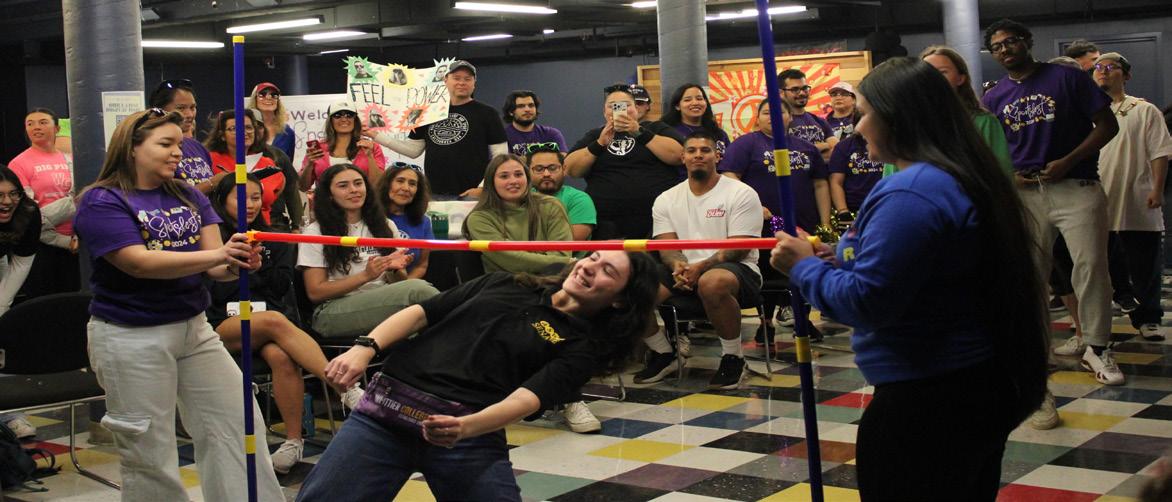
female athletes captained by thirdyear Analise Kusleika. The cheers continued as the ‘80s-themed group, Second Floor Swampers, led by second-year and Harris D second floor Resident Advisor Jasmine Rodriguez, entered with an all-green power team. The next two teams, representing the ‘90s, were the Staff Rangers and the Senatorial Slayers. The Staff Rangers followed their fearless leader, German Aguilar, to the stage in their matching Power Ranger-themed t-shirts, walking right by Senatorial Slayers captain, second-year and Vice-President Evan Josten, and other ASWC Senate members on the team. The next introduction, the 2000s faculty team, was the Kinetic Force. The introductions were finished with the final two teams, representing the 2010s, entering the stage. The Dancing Queens, a Program Board team led by fourth-year Alexie Hurtado, and the Cartels, a team composed of both students and faculty, led by Dr. Hector Valenzuela.
After the introductions were finished, director of Diversity, Equity, and Inclusion, Francisco Gomez, announced that the ‘70s competition, a game of limbo, would be up first. After several minutes of tough competition, there were two teams remaining, the Staff Rangers and The Ballers. The Staff Rangers ended up taking the victory in the first challenge, giving them an early lead.
For the next challenge, Director of Housing and Residential Life, Joe Melendez, introduced the ‘80s challenge which was a trivia quiz on the popular movie, Back to the Future. They tallied the votes from this competition as the games went on, but I had a hunch the Senatorial Slayers would bring home the win.
The ‘90s game began with Ana Gutierrez, director of Alumni Relations, discussing the rules of the popular game, Bop It. The race for this challenge was a close one, but the Second-Floor Swampers took the crown.
Brittney Plascencia, Director of Student Success and Belonging, then discussed the 2000s-themed event—a scavenger hunt. While this particular challenge was more difficult to spectate, it was enthralling watching the Second Floor Swampers run back into Club 88 after receiving first place in the challenge.
“Hope y’all had a nice warm up, meet me at the Rock!” Jabari Lewis, Director of Wellness and Recreational Sports, yelled to the contestants. Finally, the 2010s challenge, a game of team tug of war and relay races, was being set up outside. Before the game began, one member from each team took part in a dance party challenge. The teams tugged and raced, but only The Ballers had what it took to win.
Awaiting the final tally, each group took photos and a few victory laps before returning to their seats in Club 88. Finally, it was time to announce this year’s Sportsfest champion and, to everyone’s surprise (except mine), the Senatorial Slayers won.
Sportsfest may have started on the wrong foot, but I, for one, am excited for its continuation for years to come.
This article has been condensed for print. If you would like to read the full article, visit medium.com/ the-quaker-campus.
Pledging season has long passed, and prospective society members are now reaping the rewards of the initiation process. While societies such as the Palmers and Athenians had numerous students join their ranks, the Thalian Society had one inductee: fourth-year Katy Alonzo
The Thalian Society, formed in 1929, is one of the five female societies currently active on campus. They are “composed of a large and diverse group of women who share a sisterhood and an everlasting bond of friendship,” according to the College’s website. Their three fulfillments are: “friendship, loyalty, and festivity,” all of which contribute to their own motto, “Chance made us sisters. Hearts made us friends.”
But now the pressure of continuing the Thalian legacy has fallen onto the shoulders of Alonzo, who is majoring in Child Development with a minor in History. Coming to Whittier from Beaverton, Oreg., Alonzo did not expect to join any societies during her journey here at Whittier. “I never thought societies were for me; I never really had much experience with them in my other years,” Alonzo explains, reminiscing on the process that brought her to join the Thalians.
She stayed in that mindset until her third year at Whittier: “I attended the Pennette pledging and met a group of girls from almost all of the female societies. I had a great
time with them, and agreed to go to Rush. I ended up really loving the community and what it stood for.”
No other societies were of interest to Alonzo like the Thalians were, even if she had connections with other societies such as the Athenians and Palmers. “I think if I had been interested in joining them, I would have, but they all pretty much knew that if I had to go to one, I would go to the Thalians.” And that she did, all thanks to one of her friends, Isabella “Isa” Madera, a fellow Thalian.
According to Alonzo, Madera had convinced her to come to Rush events during the Fall semester, where Alonzo immediately felt welcomed. “They were just so easy to talk to; they were all so nice and really interested in me and what I liked.”
As Alonzo continued to attend their events, the Thalians made sure to keep making her feel welcomed. “During the entire Rush process, they would let me know, ‘Even if you don’t pledge, we’re still glad we got to meet you. Don’t feel any pressure from us to pledge, do what you want to do. This is your decision.’” Though apparently, she was not the only one who was heavily influenced by the Thalians’ warm embrace, “There were a few girls that showed up for Rush events; and every time they showed up, the Thalians remembered their names and fun facts about them,” Alonzo confirms. She continues, “Our biggest point is that it’s a ‘whatever’ kind of thing; once you show up,

you’re going to be welcomed.”
It was a decision that left many people questioning why a student is joining a society in their final year of college. Ultimately, Alonzo decided to join the Thalians at the beginning of the Spring semester because she recognized the value in joining an exclusive community.
Being a fourth-year student is not stopping Alonzo from making sure that the Thalians remain at Whittier; if anything, she is striving to keep the sisterhood alive. “I know all of the societies are having a hard time right now with numbers. I can post a million things about how fun the Thalians are, because, it’s great, but unless people actually show up and have
interest, it’s kind of hard to get them in.” A solution she is hoping to achieve soon is the expansion of events for societies, with a way for more people to be aware and get the societies more involved on campus. In her opinion, she feels that it will increase the number of pledges.
Soon, Alonzo will be walking across the stage to become an official graduate of Whittier College. While she joked that the question of what she would be doing next was something she wondered about herself, she ultimately decided that returning to Oreg. would be the first step in the right direction. She is unsure of where she will go from there, but she knows and confides that, no matter what, she will have
of the things about them is that no matter what you do, where you go, or how you’re doing, you’ll always have a sister somewhere,” Alonzo says reflectively. “Whatever I end up doing, I know I have that support behind me.”
While Alonzo was not expecting to become part of a society, especially so late into her college experience, she still wishes for everyone to “give something a shot” at some point in their lives. “If you’re like me and don’t think societies are for you, still go to an event because my mind was completely changed. We want to encourage everybody to do what they want to do, but we’d love to be part of it!”
College can be a very intimidating place, especially if you are coming from out-of-state. A community is something one most desires, but how do you find one? “It’s a Vibe, ‘Sis” answers that question by acting a safe place for Black-identifying women. It’s a Vibe, ‘Sis is located in the SLC building and hosts meetings every Wednesday from 4:30 p.m. until 6 p.m. They are facilitated by Counseling Center Interim Trainee Alyssa Jupiter.
“We have music, snacks and crafts, I try to tailor it to be wellness activities, just like an alternative space to therapy,” Jupiter says while describing the program. Depending on the day and theme, the activities vary. For Black History Month, they decided to go with the activities surrounding the theme of artists and artisans, and they made bracelets to bring out any creativity students might have and want to share with others. “It’s not a class or anything, but I did kind of have a curriculum around helpful practices to destress,” she explains.
She also likes to include any cultural relevance she can to the activities, not only within American culture, but other cultures outside the country as well. When it comes to goals of the program, Jupiter wants to facilitate commu-
nity, teach self-care-building skills, and build awareness for alternative mental health resources. “Typically in the Black community, there is a lot of stigma around mental health care. We’re trying to facilitate a space that sort of undoes some of that stigma,” Jupiter says. She also recognizes that students rarely have free time to come to the Counseling Center, so she sees this as an opportunity to seek out mental care.
The reason it’s identity-based is because Jupiter believes it’s hard to find those spaces. To solidify her statement, she states, “It’s also pretty unusual to be able to have someone in the mental health profession that is available to students that way.” What Jupiter was referring to is a study done by the American Psychological Association, where it stated that four percent of the Psychology workforce is Black-identifying. With how small the percentage is, Jupiter understands how important representation in mental health is for Black-identifying people. She clarifies that it is not to ignore any other identities and “[The Counseling Center is] really invested and interested in making a bunch of different groups so that everyone can have access to something like that. Since it’s a group that existed last year, I’m stepping in to continue it this year.”
One challenge that Jupiter has been facing is student engagement.
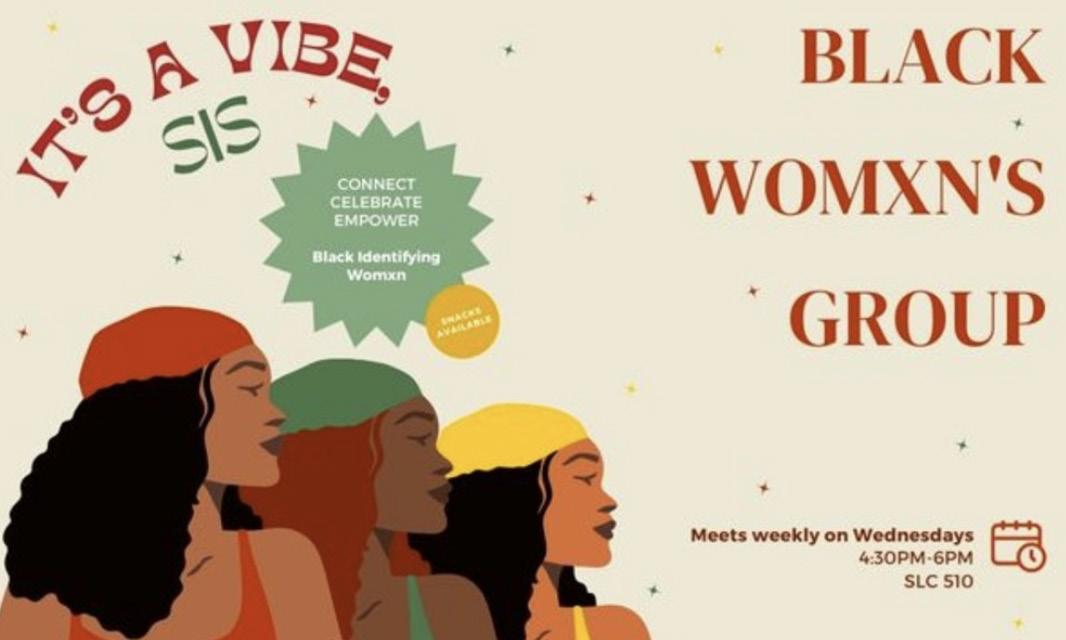
She notices that student engagement within other programs of the College is low, so she does not think it’s a problem with the evet itself. “We also have a dedicated group of girls, and I think as students you guys are busy and it’s hard to put more things on your plate,” she explained. She encourages more
people to come and to look on Engage whenever they are interested. And though it’s for Black-identifying women, Jupiter also welcomes those who are genderfluid or non-conforming. “We hold that X in women as the way we advertise is to be a little more inclusive,” Jupiter explains. She jokes, saying she’s
not going to be checking anyone’s identification and she encourages anyone looking for a safe space to decompress or connect with a community to join the group. “We’re open to people that identify culturally or anyone who will find it helpful to have that space,” Jupiter proclaims.
Men’s Track and Field at Pacific Coast Invitational @ Long Beach, Calif.
• TBD
• April 11
Women’s Track and Field at Pacific Coast Invitational @ Long Beach, Calif.
• TBD
• April 11
Baseball at Occidental College @ Los Angeles, Calif.
• 3 p.m.
• April 12
Softball vs California Lutheran University @ Whittier, Calif.
• 3 p.m.
• April 12
Women’s Tennis at Occidental College @ Los Angeles, Calif.
• 11 a.m.
• April 12
Women’s Track and Field vs SCIAC Multi-Dual @ Whittier, Calif.
• TBD
• April 13
Men’s Track and Field vs SCIAC Multi-Dual @ Whittier, Calif.
• TBD
• April 13
Baseball vs Occidental College @ Whittier, Calif.
• 11 a.m.
• April 13
Softball at California Lutheran University @ Thousand Oaks, Calif.
• 12 p.m.
• April 13
Softball at California Lutheran University @ Thousand Oaks, Calif.
• 2 p.m.
• April 13
Men’s Tennis at Chapman University @ Orange, Calif.
• 3 p.m.
• April 13
On Nov. 12, 2022, Whittier College released a statement announcing the cancellation of the football, men’s lacrosse, and men’s and women’s golf programs. Former President Linda Oubré and the Board of Trustees made this decision with the intent to refocus the College’s resources toward health and wellness programs. This announcement was met with immediate backlash; many student athletes were blindsided and upset with the administration’s decision.
But, recently a petition was added to the Whittier College website to reinstate the men’s lacrosse team.
Alumni Jon Damm and Joe McCarthey, who graduated in 1995 and 1999 respectively, are leading this initiative. Their goal is to raise $145,000 by May 7.
McCarthey grew concerned for the state of athletics at Whittier after the events of November 2022. As part of an athletics task force last summer, McCarthey assessed the impact of men’s lacrosse on Whittier College. In the few decades since its establishment, “Whittier lacrosse became a nation-wide brand,” he states. In ad-
dition to their statistical success, the lacrosse program actually had a positive financial impact on the College prior to the cancellation. McCarthey assessed tuition paid compared to the cost of the program, and found that each player represented a net positive $20,000. The departure of 40 players —the result of cutting the program last year—therefore lost the school $800,000 in net value.
McCarthey and his fellow alumni got the green light to fundraise publicly in late February, and have been doing so since early March. In little over a month, they have raised about half of the funds they need. If the baseline value is met, the College will begin by hiring a lacrosse coach, who will spend all of next year recruiting. This means the first year of the program will be net negative for the College, but alumni are prepared to cover the costs while a team is formed.
With the sports cancellation, 120 athletes were affected, many of whom transferred out of Whittier at the end of the year. Most affected athletes were warned just days prior to the announcement, if at all. Students felt the reasoning behind this decision was lackluster

and poorly assessed.
In addition to budget cuts, football and lacrosse were cut due to the relatively high risk of traumatic brain injury associated wth the sports. The College mentioned the decline in popularity of collegiate football as another reason for its cancellation. This reasoning cannot apply to men’s lacrosse, however, as it is the fastest growing sport in the NCAA, with a 60 percent increase over 15 years and the addition of 237 teams in DIII alone.
The College’s lacrosse program was particularly successful. The men’s team won 10 championships between its founding in 1980 and 1999, and recently made it to the national semi-finals in 2018. Due to its growing popularity and accolades, the decision to abolish the team was a shock to the community.
Oubré resigned in May 2023
and was soon replaced by alumna Kristine Dillon, who established $145,000 as the baseline to bring the program back. If the necessary funds are met, Whittier will apply to play in the Men’s Collegiate Lacrosse Association (MCLA) with hopes to return to the NCAA down the road. This initiative is an uphill battle however; if the program is reinstated, a whole team would need to be recruited to a program that was just cut. Additionally, travel costs will be high. Whittier’s men’s lacrosse team was the only NCAA DIII program on the West Coast, meaning they had to travel exceptional distances for games. The majority of MCLA teams are not on the West Coast, either, so any newly instated program would face a similar travel issue.
If you would like to support the initiative to reinstate men’s lacrosse at Whittier, you can donate on the College website.
Just because Women’s History Month is over doesn’t mean we will stop talking about women, especially in sports—an industry that has historically prioritized men. Now, many female athletes are rising to the top. However, that does not prevent traditional gender stereotypes from appearing, especially if they are reinforced in a historically masculine field.
As someone who participated in sports growing up (swimming, ballet, basketball, and cheerleading), I was told that some of them—cheer and ballet—were not sports. Even my high school cheer captain’s father said cheerleading is not a sport because “you don’t get hurt.” However, my teammates’ bruises from falling off stunts, sprained ankles, and back pain from tumbling would disagree. Although there is no set definition of what qualifies as a sport, Dictionary.com defines it as “an athletic activity requiring skill or physical prowess,” which can be seen in many female-dominated sports, such as aerial silk, ballet, or synchronized swimming. But until these female-attributed sports can be held in the same regard as conventionally masculine sports, the hegemonic values of gender roles will continue to remain present in the world of sports.
Although women were barred from participating in the historical Ancient Olympic Games, the first recorded female athletic competition dates back to the sixth century C.E. in Ancient Greece, where young, unmarried women participated in the Heraean Games in honor of the Queen of the Gods, Hera. Similarly, certain tribes in

Women
Ancient Africa allowed women, both young and old, to compete in wrestling traditions such as the Senegalese art of Laamb. Additionally, North American Indigenous women participated in the same sports as their male counterparts, from competing to spectating.
In the article, “First Nations Women, Games, and Sport in Preand Post-Colonial North America,” Frabrice Desalhut and Thierry Terret state, “Women’s presence in the world of games was, at the time, in total opposition to Western cultural references that were dominated by ideas of a silent, motionless and fragile female body.” These cultural values can be seen in the Victorian Age from Western Europe, where the “ideal” [white] woman was considered to be “gentle and frail.” According to this perception, female participation in any physical activity was seen a threat to their fertility, meaning that an athletic woman would be considered undesirable.
This notion spread to colonial America, where the thought of a woman participating in sports was frowned upon. Elite white women were not associated with physical exertion, unlike lower-class wom-
en, particularly their servants. Despite these recreational limitations, it was socially acceptable for upper-class women to participate in archery, tennis, croquet, and “bathing-beauty swimming” in elite women’s colleges. In her book, Coming on Strong, scholar Susan Cahn writes that these sports relied on the decorative appearance of the outfits the activities required, maintaining a feminine image while participating in physical activity.
However, women have come a long way in sports history, from having only 22 women compete in the 1900 Olympics to the passing of Title IX in 1972, which allows women equal opportunity in education and sports. The highest level of female participation in the 2020 Olympics was 49 percent, where nearly 5,400 women competed. However, there are still instances where we’ve retained the old-fashioned attitudes towards femininity and sports before Title IX.
In a sample lecture, Professor Bonnie Morris from Georgetown and George Washington University states, “As 19th-century America honed white masculinity through baseball and basketball, it also restricted women’s compe-
tition in public spheres of sports and politics by retaining inconsistent ideals about females’ innate ability to endure pain, injury, and manual labor.” This goes back to the notion of women seen as the “weaker gender” due to their limited amounts of energy—and by extension—viewing femininity as something less than in comparison to masculinity.
The article, “Gender Marginalization in Sports Participation through Advertising: The Case of Nike states,” explains, “Sports continue to be a male-dominated institution wherein hegemonic masculine ideals are constructed and celebrated, and sports that do not reinforce these ideals, such as sports associated with women, are often undervalued or ignored.” Despite traditionally feminine sports such as gymnastics, figure skating, and cheerleading being included in the Olympics, this does not prevent hegemonic gender roles from coming into view.
Josie Jones, the Diversity and Inclusion Manager of the organization Women in Sport, notes the differences between men’s and women’s gymnastic events, particularly in aesthetics. She points out that the men’s competitions focus on “strength,” such as pommel horse and rings, while the women’s competitions focus on “balance and artistic skill,” such as the beam and floor.
We, as a society, need to step back and re-evaluate the underlying misogyny present in the socially constructed genderization of sports. “Girly sports” do not exist, because athleticism is not defined by the gender binary; by denoting a sport as “feminine” we strip generations of atheletes of their hard work and accomplishments.

Hitting is arguably the most challenging thing to do in any sport due to the pitch’s speed, spin, and movement. The objective of an atbat is to hit a 9-inch, round ball at high speeds squarely past nine defenders on a field. With the development of breaking pitches like a curveball, a changeup, a slider, and just the general fiery fastballs, it has become increasingly more challenging to be successful at any level. In a game where failure is inevitable, Teige Barrett has found a way to cement himself as the consistent key to Whittier’s baseball success this season, and a hitting machine recognized at the SCIAC conference level.
A good hitter successfully reaches base three times in 10 at-
bats, which seems easy enough to accomplish at first. However, only the rare few can boast this accomplishment at any level, much less the collegiate one. Teige Barrett, a fourth-year, claims a .328 batting average with immense success in the first half of the season. As a result, Barrett earned the SCIAC Hitter of the Week award for his contribution to the Poets’ wins. Barrett expresses his appreciation for the recognition, “It is a great honor to receive this award. SCIAC is one of the best Division III conferences in the nation, meaning that there is great competition,” which makes it all the more rewarding. At less than half-point in the season, he is only one home run shy of his previous season record and shows no signs of slowing down. He leads in the home run category, runs batted in,
and total bases, solidifying his essential position at the heart of the lineup.
While hitting is mainly considered an individual feat, winning a game takes a team’s collective intention. Barrett attributes some of his consistency to the other men who play with him. “My success at the plate throughout this week was primarily because of my teammates who hit before me, including Nathan Sherman, James Stirton, and Lew Rice who were consistently getting on base.” He continues, “This presence on the base paths put pressure on the pitchers and defense during my atbats, making my job much easier and giving me better pitches to hit. Dangerous hitters behind me, like Max Berber and Ian Watanabe, also made it easier on me as pitchers had to throw me hittable
strikes.”
While this may be his belief, players behind him in the lineup, like Maximus Berber, one of the hottest hitters at the moment, expressed a similar opinion of Barrett: “When Teige gets on base, it motivates me to score him when I’m hitting. More runs equal wins, so when guys start hitting, it has a snowball effect on the other guys in a successful way.” Berber points out that the “snowball” effect often influences baseball teams, sometimes negatively and positively. There is a phrase frequently uttered among coaches alike, “Hitting is contagious!” Though each at-bat is a singular event, pitchers get rattled when there is a consistent opponent. It also inspires confidence in the rest of the lineup.
For many athletes, the mental part of their sport is one of the most essential and catalytic aspects of performance. Hitting is mainly mental, leading to players incorporating routines to get them in the right headspace. Barrett discussed his preparation process, “Before each game, I have the same routine of getting treatment from the trainers and dressing in the locker room. This routine helps me relax and prepare for the game through consistency.” He explained, “Before each at-bat, I try to take a second to focus on my breathing and control my heart rate. I also have a pre-pitch routine that I have done since I was about 12, and it has stayed pretty consistent throughout my time playing baseball.” Barrett attributes his in-game steadiness to this routine, claiming that it helps him keep a clear head and stay focused.
Knowing what to expect from
themselves as hitters allows the athlete to have a clear goal, allowing for a greater chance of success. Success is often defined differently based on every situation, such as moving a runner to the next base, getting a deep SAC fly for an RBI, or having a quality at-bat that makes the pitcher throw lots of pitches. A great hitter will recognize what hit the situation calls for and do their best to provide that clutch moment.
Barrett always employs his distinct mentality in each game: “My goals when I go up to bat are to do something to help my team win and score runs. So, a successful atbat changes depending on the situation, but my main goal is to get a good strike that I can hit hard. If I hit a ball hard in an at-bat, that is a success. Even if I get out, the hits will come if I keep hitting the ball hard.”
Anyone can see the value that Barrett places in ensuring that his individual actions contribute to the efficiency of his team. Barrett’s performance is not concentrated on individual excellence, but rather on ensuring that he helps his team, his family, as best as he can. It is this sense of ethic that solidifies Barrett’s reputation as the Poets’ most reliable person in the lineup and earned him the Hitter of the Week award. “I just try to show up every day and put in the work I can to prepare myself best for each game to help us win. To achieve this, we must give our all every day and season. But this is a special team, and I think we have the chance to do something great this year.” With Teige Barrett’s powerful bat, the Poets look to make the SCIAC tournament and anticipate a playoff run.
With tennis season in full swing, this year’s women’s tennis team is working extra hard. That is, according to Interim Coach Jackson Boxall, who was chosen to be Head Coach of the women’s tennis team this semester. A former high school coach, Boxall is joining Anthony Sena, the new men’s tennis Interim Coach for the 2024 semester. When former tennis coach Aron Magrigal stepped down, Boxall stepped in and secured the role of women’s Head Coach for the Spring 2024 semester.
At 23, in a baseball hat and track shorts, Boxall looks almost like a student himself. But do not let this fool you. At just 18 years old, he transformed a high school tennis team into state quarter-finalists. And now, a few years later, Boxall has entered the College scene after being an assistant coach for the men’s and women’s tennis teams last semester.
When it comes to his new role, Boxall brings his high hopes to the table, “The goal [for this season],” Boxall explains, “is to start shifting the tide, to get into this new chap-

Jackson Boxall has been named the new Interim Coach for Poets’ women’s tennis. ter of Whittier College tennis.”
Formerly nationally ranked, Boxall anticipates placing the team exactly where it was before in a matter of two years—and they just may be getting there. While this season has seen a mix of wins and losses, with mostly losses, the team is on the incline.
The women’s tennis team defeated Lewis and Clark College, an NCAA team with an impressive win of 6-3. According to Boxall, the points keep improving throughout the season and demonstrate improvement from last season.
Boxall’s young disposition is what connects him to this year’s team. According to Boxall, he brings a level of understanding that older generations do not. This ability Boxall also attributes to his experience as Valencia High School Tennis Coach. Boxall speaks highly of the team and calls the “sense of community” one of their greatest strengths, displaying this on and off the court. This family dynamic, says Boxall, is what makes the College so special, especially in the athletic field. “We’re supporting one another,” Boxall proudly
states, “Even [that] is what being a Poet is all about.”
Another strength the girls bring to the team is a passion for improvement. “These girls want to get better, they want to work hard, they want results to start happening. It’s just the amount that they’re willing to do is a lot better,” Boxall finishes.
But this season does not come without obstacles. Two semesters ago, Whittier cut multiple sports programs, sparing men’s and women’s tennis. This fear is what follows recruits. However, according to
Boxall, the tennis team has seen an increase in participants within the past weeks. Boxall attributes this to the work done by Athletic Director Rock Carter and Interim President Kristine Dillon to usher in new athletes. Boxall also notes that there is an improved connection between athletes and administration.
Recently, tennis players were present at the President’s Luncheon, which, in Boxall’s eyes, is a big step from last year. Nevertheless, when it comes to the future as Interim Head Coach, Boxall is unsure about his position in the long term but seems content with his role here at the College. “I’ve expressed my interest in staying,” he laughs heartily. “If I’m offered the position, I’d love to stay.” With their increase in wins, the women’s tennis team seems to be thriving slowly but surely under Boxall’s leadership.
Let’s see how well the Poets fare for the rest of the season! The next home game is at 3 p.m. against the Occidental College, this Saturday, April 13. Come out to Hugh B. Mendez Stadium and show your support for the team. And as always, go Poets!
For as long as she can remember, Victoria “Tori” O’Campo knew she wanted to be a writer. From Harry Potter to Emily Dickinson, she found herself enamored with the words woven on the pages. Dedicated to the craft, the young writer spent countless nights creating her own stories.
“I was a freak kid,” O’Campo says with amusement. Dressed in a brown sweater, wearing a pair of red Pacman earrings, O’Campo sits behind the Zoom screen as she recalls one of her first written pieces: “I told my mom, ‘I’m going to lock myself in your bedroom and write for half an hour.’” And that she did, losing herself in a world of poetry.
This love for writing followed O’Campo into high school, blossoming into a love for the visual arts as well. “I’ve always really loved written word,” she says with a fond expression. “[In high school] I had this awakening, like, ‘Oh my gosh, visual arts can portray the same kind of ideas’ and [I] just fell in love with that.”
This passion that fueled O’Campo’s artistic spirit eventually channeled her political values. Although she did not consider herself to be the “best student” in high school, O’Campo was determined to make a difference in the political sphere after graduating. Upon hearing about Whittier’s—now closed—Law School, this piqued her interest in the College, seeing it as a potential career pathway into law. After receiving her acceptance letter, the San Dimas native made her way to the College in the Fall of 2017, on the path to fulfilling her childhood dream of becoming a Poet.
While O’Campo was immersed in the world of political science, her love for writing persisted, prompting her to join the Quaker Campus. Pushing past her nerves of being surrounded by new people, O’Campo took up an article after the first meeting. Soon after, O’Campo found herself “wrapped into the madness” that is student journalism, writing more articles, particularly for Arts and Entertainment (A&E). “Being able to write—whether it was about music, movies, or whatever—really gave me the space to explore that interest I’d always had.” She became an Assistant Editor and
later on, the Section Head of A&E.
Like many students after their first year of college, O’Campo began to reconsider her career path that summer. Despite her major, taking Political Science classes took a toll on her mental health [and she didn’t enjoy them.] “I was reflecting on that, being like, ‘These [writing courses] are the classes I’ve enjoyed the most. Why don’t I go down the English [major] route instead?’”
And she never looked back, deciding to take more classes in the English Department. Among the many classes she took, one course that left a significant impact on O’Campo was Editing and Publishing Emerging Media, where students manage and produce the award-winning literary and arts journal, The Greenleaf Review, every Spring semester. Already having the “print media experience,” O’Campo stepped in as the Creative Director, helping create a “cohesive ‘visual language’” for the 2020 Greenleaf Review: Road Closed Ahead issue in her third-year.
However, plans for the GLR began to slow down after going home for an extended Spring break. But rather than being upset at the disruption in the flow of production, O’Campo remained understanding. “I think people fell off, and fair enough, because everyone was going through everything that happened those last few
of always knew that I was going to be Editor-in-Chief,” O’Campo reflects. “They were kind of training me for it, in a way. So I had that in the back of my mind.” However, the emerging Editor-in-Chief did not expect to be running the Quaker Campus remotely, spending the summer developing a new website for the newspaper with the influx of digital articles. During this hectic time, O’Campo often questioned her capability as Editor-in-Chief, expressing that, “I was really intimidated, and being Editor-in-Chief, I struggled a lot with imposter syndrome.” Despite this, O’Campo’s experience in being a part of the QC and other leadership positions served as a reminder for her to remain faithful to herself. “Having those leadership experiences in a fairly safe environment was really helpful in trying to overcome that [imposter syndrome],” she explains. “It’s just a matter of trying to remind yourself, ‘I work really hard. I’ve been over here crying over InDesign for an hour, and I just spent my entire week working on this.’ That’s beautiful, and that’s amazing, and it shows so much work, effort, and intention.” The passion in O’Campo’s voice remains clear through the speakers as she recalls these experiences.
After finishing her classes in January 2021, O’Campo contin-
“A few stubborn people like me were like, ‘We’re going to keep it going, and we’re going to print it.’”
-Tori O’Campo
months,” she says after a brief pause.
Despite this, O’Campo persisted, allowing her and a few others to work on the journal through lockdown. A look of pride shines on O’Campo’s expression as she states, “A few stubborn people like me were like, ‘We’re going to do this. We’re going to keep it going, and we’re going to print it.’” In spite of it all, this determination throughout the remainder of the semester is what brought the 2020 issue come to fruition. Simultaneously, as the then Managing Editor of the Quaker Campus, O’Campo was preparing for changes in leadership. “I kind
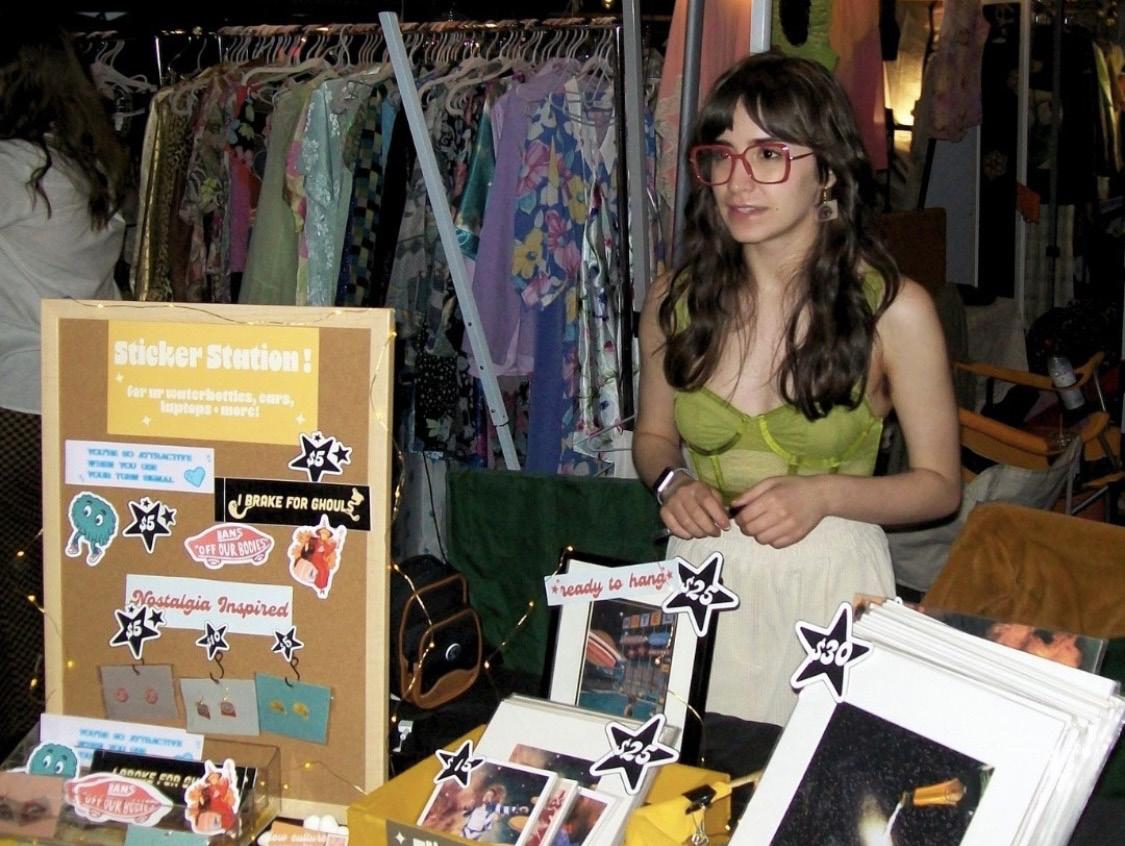

she deserved something better. “If I put that energy that I’m pouring into this company into myself and into my own business, then I feel like the rewards will be better,” she explains. Through all this, O’Campo was freelancing at the non-profit magazine The Red Canary on the side as an Editorial Assistant. After deciding to pivot from marketing, O’Campo sent in her application, received an interview, and became a Managing Editor of the magazine.
ued to remain involved with the Quaker Campus and The Greenleaf Review, with graduation months away and the low demand in the job market. O’Campo says earnestly, “I wanted to help keep it going, at least through the end of the year.”
The skills O’Campo developed from her media and publishing background helped after graduation, although not in the field she expected. Quick to find a job right after graduation, O’Campo accepted the first offer she received in SEO content management. “I never thought I would be in marketing,” she explains, “but I quickly found out that a lot of writing jobs are marketing jobs.” In the months leading up to her graduation, O’Campo freelanced online SEO articles to make money on the side, providing her with experience in the field. Despite this, O’Campo was not fond of the work environment, comparing it to the lawyers from the crime drama Better Call Saul. “The work environment ended up being pretty misogynistic,” she adds, “So I was like, ‘OK, I got to get out of here.’”
Upon receiving another job at a tech startup, O’Campo quickly became the Senior Marketing Manager where she remained there for a year and a half before deciding to make a career pivot. Unsatisfied with the company culture, O’Campo knew
Having worked there for nearly three years, O’Campo joyfully expresses her feelings about working at the non-profit, stating, “I absolutely love working at The Red Canary. To work in such close proximity these writers that are award-winning themselves, and to work on these award-winning stories, I am constantly in awe of it.” Although it was a difficult decision at first, she can proudly say that she loves her work as a freelancer.
While working remotely at The Red Canary, O’Campo also works freelance as an Editorial Contributor in Nashville, Tenn. Being at home for nearly two years, O’Campo was ready to broaden her horizons. With a majority of responses coming from Nashville, O’Campo took it as a sign to venture across the country, eager to explore a new city and its growing music and art scene.
A self-described “California girl at heart,” O’Campo did not expect the culture shock of moving to a different state—starting with the weather. “It’s a lot colder here,” she says amusedly, “and I did not know that before moving.” Additionally, moving to the South after living in Southern California her entire life was a unique experience, adjusting to life outside the West Coast. Living away from home causes one to experience homesickness as O’Campo’s family—her parents and three younger sisters—are still in California. Despite her busy schedule, O’Campo makes it a priority to visit every few months. “Even then, I wish that it was a little bit
more frequent,” O’Campo muses. Although she is away from home, O’Campo continues to enjoy living in her new city by finding new things to explore. A typical day in O’Campo’s life includes visiting the coffee shops, antique stores, and the local art markets. Another aspect O’Campo enjoys is the music scene, attending venues whenever she knows there is a good show. One particular memory that stays with her was in Knoxville. “My boyfriend surprised me with Paul McCartney tickets,” O’Campo exclaims with a big smile. “That was, a life-changing moment.”
Having a deep appreciation for the arts, O’Campo continues to fuel her creative streak, running an art brand called Low Culture Committee, consisting of various collages and posters. Many of her art pieces come from collections of vintage magazines, turning them into silly memes and collages. “A lot of that was shaped from working on different publications and figuring out that I really appreciate page design, which I didn’t know until doing that.”
In addition to her art brand, O’Campo strives to continue to write. Combining her two interests—writing and visual media— the creative set up her own newsletter. Sharing the same name as her art brand, O’Campo saw it as an opportunity to talk about the visual pieces she created. Reflecting back on her experiences, O’Campo says, “I can’t imagine not being in a creative industry at this point. I’m constantly creating things in some way.” She concludes with a smile, “If you’re interested in it, be honest to yourself in that call to create if that’s something you’re interested in doing.”
Whether it is making a career change, managing two student publications in the middle of a pandemic, or running her own art brand, O’Campo’s resilience shines through. Victoria O’Campo exhibits that it is possible to accomplish anything with passion and tenacity.
A long, long time ago, before 5G networks, ChatGPT, and smartphones ruled the planet, when Bluetooth connectivity was considered new, advanced, and even cutting-edge, life seemed to lack the underlying digital hum prevailing today. Without constant online alerts, notifications, and Google Calendar reminders refusing to let you arrive late to your next online Zoom meeting or quick 15-minute coffee date, there seemed to be no hurry to live life. It should be said, however, that perhaps back then, life was also, in many ways, less convenient.
I was not born in a time that completely lacked technological enhancements, like the Dark Ages or when dinosaurs still roamed the earth, bumbling through existence, or caveman using stone-tipped spears for hunting for food. I was born 22 years ago on June 30, 2001, which was a year when phones had just begun adorning color screens, FM radios, and daily organizers.
This comparison seems blatantly apparent in terms of difference, and I am not speaking as if I have any way of knowing what it was like to live in a world utterly unconsumed by technology. But, I must admit that the world in which I was born shows stark and salient contrast to our current one, demonstrating how genuinely far we have come regarding reliance on transportable handheld devices known as phones.
I am proud and slightly boastful to say that for five years, 11 months, and 29 days of my entire 22 years on
this planet, I existed in a society and culture that had yet to experience and succumb to both the great pleasures and consequences of the invention of the iPhone, released exactly a day before my sixth birthday. Launched and distributed to the public on June 29, 2007, Apple’s original iPhone 1 was marketed as a $399, 16 GB product with a laughable 2.0-megapixel camera, and 3.5” screen (CNN). Although I regrettably cannot recall the first time I held an iPhone, (as my five-year-old brain was incapable of knowing how much that memory would eventually mean to my 22-year-old self), I do often find myself marveling at how people once managed to wake up without the help of an automatic virtual assistant’s gentle nudge or the blaring jolt of noise. I cannot imagine the open road without the ease of knowing that thanks to the tiny human who lives within our devices and remains restless until finally guiding me home, getting lost in a foreign place is almost impossible.
It is not a question of whether or not our generation relies too much on our phones but rather what this reliance will mean for the future and our lives as human beings. Particularlry, as we move into new and possibly even more dangerous technological territories yet to be discovered.
“According to a small Stanford study, children are getting their first phone around the age of 12. If the average life expectancy of an American is 76-years-old, that would mean the average American will spend 12 years staring at their phone screens over their lifespan,”
according to harmonyhit.com. I think many people are far too involved with their phones and that our dependence on them is indeed socially unhealthy both in terms of limiting physical and social interaction, and of that “always on” lifestyle that is reflected at Whittier College.
In a survey created by the Quaker Campus, sent to the student body, shows that 41.2 percent of 17 respondents use their phone excessively. Of the respondents, 29.4 percent admit they cannot go 15 minutes without their phone. Most of the responses said that Instagram, and TikTok were their most used app. 41.2 percent of respondents agreed phones alineate pople form each other, but a same percentage disagreed. For the section asked if they navigate life without their phone most responded no. One anonymous respondent said they needed their phone because they don’t know how to get to school from home. Another anonymous respondent commented: “Although I use my phone for useful things like FaceTime and Maps, I find myself
just scrolling mindlessly on Instagram or YouTube a lot” Mindless scrolling happens a lot. We consume so many things that people post, we lose sense of time. I do not think we need to share every detail of one another’s lives on every social media platform or publicize every minor news break that transpires 24/7.
As the world we live in today has dramatically changed in everexpanding ways in just the last 20 years, technological advancements and electronic shifts have moved our global population into a newfound digital age with constant innovative possibilities and progress continuing to rise, penetrating modern-day society’s present and near future. This generation faces more problems related to the environment within their adulthood than any other generation as we currently live through a crisis period of terrorism, the global recession, and climate change. Will technology ever solve the problems we face today, or will it be the end of us?

Have you ever asked yourself, “Wow, I wonder how many people in the United States use TikTok?”
In the US alone, there are over 150 million monthly TikTok users — that’s almost half of the entire country’s population. Of course, we have to account for the users who have multiple accounts, but the data doesn’t record how common that is, so we will just have to find satisfaction in knowing that there are a lot of people in the US using TikTok on a regular basis.
In recent years, TikTok has amassed criticism almost as quickly as it’s amassed users, reaching a point where the US government has now taken serious action to ban the app. But why? What could the government have against an innocent app where people share videos of themselves dancing, participating in throw-back trends, and making silly commentary? The official answer lies in the fact that TikTok is owned by ByteDance, a privately owned Chinese technology company based in Beijing. Lawmakers in Capitol Hill have displayed intense unease at the origins of TikTok’s parent company, even though the app is not available in mainland

China and is based out of headquarters in LA and Singapore.
On March 13, the House of Representatives voted overwhelmingly to ban TikTok on a nationwide basis unless ByteDance agrees to sell it to a non-Chinese owned corporation. This move prompted major pushback from across party lines as concerns about the protection of free speech were raised. Former President Trump tried (and failed) to ban the app back in 2020, but has since backtracked and changed his stance on the matter,
now agreeing with those who claim that banning the app violates freedom of speech. President Biden, on the other hand, has stated that if this bill receives approval from the Senate, he will sign it into law. He, however, has not officially endorsed the bill.
But in the past six years, TikTok has amassed four billion downloads and now has over one billion monthly active users. The app’s appeal has been closely studied by researchers due to its explosive popularity and it is fairly well ac-
Dear Poet, What should I do as a last hurrah before I leave school for the summer?
Sincerely, A Mischievous Poet
Dear Poet,
The sun is out, my will to live is back, let’s get into some mischief!
Starting small, if you haven’t skipped class this semester then I suggest you skip class. If your professor grades by attendance then tell your professor you’re taking a mental health day! You need it. If you want to be more dramatic, tell them you’re very sick and need to go to the sea to restore your health. The very act of writing the email pains you. Woe is you.
Next! Don’t go anywhere near campus! Today is about protecting your peace and you can’t do that if you’re on campus. However, if the school grounds has a death grip on you, then I suggest you go and explore a part of school you haven’t seen this semester. Go throw a paper airplane off the fifth floor of the SLC! (Editor’s Note: Ask a Poet does not reflect the views of the Quaker Campus and things should not be thrown off the fifth floor of the SLC).
Now, if you can bear to part with your precious campus, I say go for a little drive! Go watch a movie! Go anywhere that you normally wouldn’t be able to go because you’re stuck in a classroom! Be wild and free. That being said, you are not using this time to be “productive” or get extra errands done. You’re having fun today. Do it!
cepted that TikTok’s allure is due to the increasingly short attention spans attributed to the general public. Stefan Murariu explains that short-form video sharing platforms (such as Vine, TikTok, and Musical. ly) emerged in response to modern audience’s devolving attention spans. Murariu backs this claim up with data that compares the average human attention span of 12.5 seconds in 2000 to the average human attention span in 2015, which was 8.25 seconds. This demonstrates a 25 percent decrease in the longevity of our attention spans, which could act as a partial explanation for the popularity of platforms that prioritize quick videos over lengthy ones, such as those posted on YouTube. For many users, particularly Gen Z and Millennials, TikTok is a platform that keeps them informed by making information about social issues, politics and elections, environmental concerns, and general breaking news more easily accessible. Eliminating TikTok could greatly impede users’ access to content of this variety, which is rightfully concerning.
This article has been condensed for print. If you would like to read the full article, visit medium/ the-quaker-campus.
Okay, if you take issue with driving around aimlessly as a pastime, we wouldn’t make very good friends. But here’s the sitch: since you’re not going to school today, you should go to places you can’t normally go to because of your responsibilities. Go to a museum on a Tuesday! LACMA is free every second Tuesday of the month from 11 a.m to 6 p.m. If you’re a fan of Ask A Poet, you know that I’m a fan of museums. Especially free ones.
Dear Poet, I’m so proud of all the work you’ve done this semester. Now it’s time for a little treat! Good on you for recognizing that! I hope that your day off is refreshing and that the rest of the semester goes well for you.
Hang Loose, A Poet
P.S. Have you ever seen Ferris Bueller’s Day Off? You may want to watch it to get some inspiration! But we don’t live in the eighties or Chicago, so take that into account.
Need advice? Fill out the Google Form in the Quaker Campus Instagram bio, and your question might be featured!
Spanning from March 17 to March 18, true crime documentary channel Investigation Discovery partnered up with the streaming service Max to bring a new documentary. This documentary, titled Quiet on Set: The Dark Side of Kids TV, centered around the stories of writers and child actors from Nickelodeon during the late 1990s and early 2000s, explaining what they had gone through behind the scenes.
What the kids went through behind the scenes is unimaginably horrible. These stories ranged from raciall insensitive sketches on the show All That, to being forced to perform pedophilic-related humor. Even the parents of said actors had their own set of traumatic stories, like Bryan Christopher Hearne’s mother who was being mistreated by the showrunners for standing up for her child. This included production assistant John Handy, who sent inappropriate photos of himself to child actors. The parents of the children chose not to report this to the authorities for being afraid that they would look like “bad parents.”
The biggest discovery of Quiet on Set was the information about Drake Bell’s sexual assault by his own dialogue coach, Brian Peck, when he was just 15-years-old. The third episode tells about how he was groomed by Peck, to the point where, in the middle of the explanation, Bell starts to tear up, apologizing that he recount everything that had hap-

pended, as it still hurt him all these years later. He recounted how Peck caused a separation between Bell and his father, along with Bell’s mother refusing to comply with his father’s wishes to not let Peck near Bell, and the lack of any parental awareness after Bell’s father was removed as his manager.
Soon after the documentary skyrocketed in popularity, Dan Schneider, the primary showrunner that was exposed, held an interview with iCarly actor, Bobbie Bowman,
best know for his role as T-Bone to discuss the situation. According to Schneider, the series had been hard for him to watch, claiming, “I definitely owe some people a pretty strong apology.” Schneider is trying to excuse himself now that he is backed into a corner, and Nickelodeon is not acting any better. The only statement they’ve released— which was seen at the end of every episode—is as follows: “Nickelodeon, as a matter of policy, investigates all formal complaints as part of our
commitment to fostering a safe and professional workenvironment free of harassment or other kinds of inappropriate conduct.” It continues, “Our highest priorities are the well-being and best interests not just of our employees, casts and crew, but of all children, and we have adopted numerous safeguards over the years to help ensure we are living up to our own high standards and the expectations of our audience.” This is a basic apology; and just seems insincere, considering the network has
the power to prevent these heinous crimes in the first place.
A common argument made about Quiet on Set is that, outside of the Drake Bell situation, a lot of the accusations about Dan Schneider were well-known years earlier. The public was aware of Schneider’s horrible behavior towards his actors, but we were still exposed to extra details and footage that were never released, and even more insight into his questionable relationship with actress Amanda Bynes.
Actors such as Josh Peck, Alexa Nikolas, Nancy Sullivan, and Kenan Thompson have publicly expressed their support for the victims who had spoken up, and their distaste for Nickelodeon and Dan Schneider.
Even one actress, Amber Frank from The Haunted Hathaways, came forth about the channel now that her fellow actors were doing it. She disclosed that when she started on her show, the crew was sent computers from Nickelodeon, with child pornography visible when they opened it.
No words can describe the emotions felt when this was released online. What do you mean Nickelodeon, the channel meant for children, issued pornography to minors and yet no reports were made? It’s sickening, and but there is still so much more to be uncovered.
Whether or not changes will be made is still unclear, but public outrage can push companies to pay attention to the crimes that have been commited by their staff, and take responsibilty for their actions. Hopefully thiswill help bring closure and healing to all the victims of child abuse in the film industry.
Growing up, I would always see women in my household getting ready for the day with their meticulous skincare routines consisting of anti-wrinkle creams, serums that prevented age spots, and powders that hid blemishes. I would hear relatives gossiping about their high school classmates’ posts on Facebook, commenting about how they looked “two decades older’’ than their actual age, worried that they would “be next” to experience the oh-so horrifying wrinkles. The fear of aging is not just within familial influences, but socially ingrained.
In the article “Aging in America: Ageism and General Attitudes toward Growing Old and the Elderly,” Raqota Berger writes, “At the center of this marginalization and devaluing of the elderly is the mass media. The mass media has largely become the central nervous system of American society and has a massive impact on people’s values, beliefs, and perceptions.”
In a society that values self-image, it can be difficult trying not to be self-conscious about your appearance, especially with influencers promoting beauty and skincare products on social media. What’s concerning about this is that many of these products are being targeted towards children, some as young as 10-years-old.
In an interview with The Guardian, Dr. Anjali Mahto, a consultant dermatologist from Self London, mentions that it’s a common occurrence for her to see younger patients at her clinic.
“Most have been heavily influenced by social media (TikTok in particular) and influencers who are showing their in-depth routines, most often accompanied by luxury skincare brands.”
If their skin needs additional products, they should speak to a board-certified dermatologist. Any other product, especially if it includes retinol, would be harmful for their young skin.
It can be difficult trying not
to worry about aging in a society where being youthful is highly valued in comparison to growing in age, “even more so with fashion trends such as the “coquette aesthetic” on the rise. Writer Ian Kumamoto describes the aesthetic as “fundamentally about nostalgia and reverting back to a childlike state of comfort.”
While wearing bows and lacy dresses is not inherently infantilizing, those are common markers associated with childhood due to their soft, dreamy nature. And while I do love the reclamation of femininity the coquette aesthetic inspires, it also makes me skeptical of its role within society’s pedophilic beauty
standards towards women.
In Taylor Percella Smith’s article titled “The Infantilization of Women and Pedophillic Beauty Standards in Western Culture,” she comments on this, stating, “Our society has normalized this infantilization of women with pedophilic beauty standards and sexual expectations, and although it may be a controversial take, it is clear as day once you begin to see examples of it manifest around you everyday.”
Smith continues, “From hair removal, to pornography, to child pageants, to the erasure of tweens, and the emphasis of appearing youthful, the signs are flashing red all around us.” That’s not to say following any
of these standards is wrong; in fact, I shave, I pluck my brows, and I love wearing cute dresses. But what’s frustrating is that we’re expected to maintain a certain level of youth, even if we’re considered to be “past our prime.”
But despite there has been some progress made in striving to change ageist attitudes. By unlearning our own internal biases towards aging— and changing our harmful overall mindset—this can help destigmatize our societal views on aging. With tthe current progress that’s been made, I am hopeful for a wrinkle-friendly future. Maybe then we’ll be able to show off our gray hairs and smile lines as achievements in our lives.
 Nickelodeon gets exposed for the mistreatment of the child actors.
Nickelodeon gets exposed for the mistreatment of the child actors.
Want to know what our Head Copy Editor recommends this week? Read on!
Music:
An artist I stay obsessed with is the one and only Erykah Badu. Currently I have her album Baduizm on repeat. I love listening to it at the beach, as I’m cooking, on a drive, or even while I study. Its rhythmic beats and Badu’s enchanting voice makes it the perfect album to play.

Food:
I was recently introduced to Ethiopian food and have been craving it ever since. A restaurant I find myself coming back to is Messob in Mid City. The mixture of flavors and spices were something I had never tasted before, and I was amazed at the wide variety of unique and authentic dishes they have to offer.

TV:
I am currently in the process of rewatching Breaking Bad for the fourth time, and although I can summarize every episode of every season, its top-tier acting, complex characters, and captivating cinematography make it a must-watch show (but, I would recommend watching Better Call Saul beforehand).

Snacks:
I’ve come up with several snack combinations that I now have to restrain myself from eating constantly, and my most recent was Trader Joe’s Mediterranean Style Hummus combined with their Unexpected Cheddar Cheese and slices of Persian cucumbers, all of which I will sometimes wrap in a tortilla and top off with Tapatío hot sauce.

A notorious con-man is on the loose, and the FBI must find him before he can gouge out more money. But what happens when that dastardly crook is nothing more than a lonely teenage boy?
Whittier College’s Theatre, Film, and Communication Arts Department, in collaboration with the Music Department, opened their production of Catch Me If You Can at the Shannon Center’s Robinson Theater on April 4. See “Catch A Flight For Catch Me If You Can” on the Quaker Campus Medium if you would like to learn more about how the production was made.
Catch Me If You Can tells the intrepid story of Frank William Abagnale Jr. (Jonathan “J.J.” Trimble)—who you may know by one of his other aliases. He ran away from home after his father, Frank Abagnale Sr. (Aidan Alvarez), and mother, Paula Abagnale (Cielo Valenzuela-Lara), divorce. But all the running around soon leaves Junior broke. So he starts cashing in fake checks, going by different names, and taking up a variety of occupations including a pilot, doctor, and lawyer. But that catches the
attention of some very important people—a.k.a. the Federal Bureau of Investigation. Chief Carl Hanratty (Joel Adell) will not stop until the boy is caught.
This production is one word— explosive. The musical starts off at the climax of the story, when Junior is about to be caught by Hanratty at the airport. Right when the climax is about to occur, Frank uses his most surefire assets—his wit and his charm—in order to tell the story of how he almost got away with it all, but through jazzy song and dance!
The one hitting those high notes is Trimble, who plays Frank with both the dazzle and sincerity the character demands. Trimble can woo the audience with daring adventures and lovable swagger, but he also allows the character to have the emotional moments needed to fully realize the con-man persona of a teenage boy wanting attention. Trimble is also an incredible singer, drawing out long notes with an almost operatic style to them. Trimble captivates the audience whenever he is on stage, and even when he’s off, you say to yourself, “Man, I wish I could see more of him.”
Playing the narrative foil to Trimble is Adell. Adell is the straight-man in the over-exuberant world that Junior has created. Adell
is headstrong, and one can tell that he cares deeply about a character that can come off as the villain of the show. It’s not easy being the antagonist, but Adell plays it oh so well. Adell really shines in numbers that allow him to sing in a lower register, but still ooze the jazzy coolness the show as a whole demands.
While Adell does great on his own, when he is met with Trimble, it’s like a match made in heaven. The two play off each other’s differences in order to make something truly special.
With a production that is so focused on the boys, seeing the girls command the stage through dance, song, and pure charm is a refreshing treat. Most notably is Frank’s love interest, Brenda Strong (Carly Mandell). Mandell ultimately excels during her tender ballad “Fly, Fly Away,” invoking the feelings of wanting to make sure the one you love will be okay in the end. She demands the audience’s attention, even when they might have tears in their eyes.
This production really shines when you see the entire ensemble come together for the huge numbers. This show has a lot of moving parts to it, and while energy can waver from section to section within the cast, they always know how to

The show was the biggest yet.
have a great time.
The technical aspects of the musical are totally far-out, even when the microphone sound levels seemed a bit uneven at times. The set is large and colorful, incorporating the use of stairs and levels in order to make this production even bigger. The costumes are fun and indicative of the time. But the best part was the lighting design, allowing for the funkadelic ideas to come through, and create an almost palpable texture to the stage.
This show feels like something huge. This is really the biggest show I have ever seen in the Robinson Theater. It is a beast of a production, but the cast and crew put it on effortlessly.
This article has been condensed for print. To read more, visit medium. com/the-quaker-campus
“Nothin’ really ends. For things to stay the same, they have to change again.”
These are the groundbreaking opening lyrics to the first song, “AMERIICAN REQUIEM,” of Beyoncé Carter Knowles’ highly anticipated eighth studio album, COWBOY CARTER. With debates and controversy surrounding Beyoncé’s ability to perform “country”—see “Beyoncé vs. Country Music Radio” on the Quaker Campus Medium—it was unsurprising for Queen Bey to begin her album by stating what’s on her mind.
COWBOY CARTER consists of 27 songs and includes collaborations with artists such as Dolly Parton, Post Malone, Willie Nelson, Linda Martell, Shaboozey, Tiera Kennedy, and even her youngest daughter, Rumi Carter. The album can be broken into three parts, split between transitional tracks that help organize the various moods that listeners experience as Knowles
blends multiple genres with country music. The result is a witty, well-organized, and unique country music experience that reflects Beyoncé’s talent and versatility as a musical artist.
The album begins with “AMERIICAN REQUIEM.” A song that takes us to the desert, as the soft sounds of a sitar echo the feeling of an old western movie. Beyoncé then leads us to the local town church, as a melodic choir echoes in gospel. The song serves not only as the first song to the album but also as Beyoncé’s thesis statement, as she sums up the road leading up to this album: “They used to say I spoke, ‘too country.’ And the rejection came, said I wasn’t ‘country ‘nough.’ Said I wouldn’t saddle up, but if that ain’t country, tell me what is?”
Next comes “BLACKBIIRD,” a cover of The Beatles’ 1968 song, which Paul McCartney and John Legend co-wrote in response to the discrimination they saw on television during the integration of Black students into white schools. The

song features vocals from young Black female country artists Tanner Adell, Brittney Spencer, Tiera Kennedy, and Reyna Roberts. The collaboration was yet another statement by Beyoncé on the recovery of Black influence in country music, and kudos to the Queen for uplifting fellow artists within the community.
“PROTECTOR” includes the voice of Beyoncé’s youngest daughter, Rumi Carter, and speaks about the desires a mother has for her child’s happiness, hoping to always be their “protector” and “projector.”
Leading the second part includes her version of “JOLENE,” which plays after the introduction track “DOLLY P,” featuring, you guessed it, country music legend Dolly Parton. Unlike “BLACKBIIRD” where Beyoncé covers the song word-for-word, she adds her own lyrics to “JOLENE” while keeping the famous chorus.
“DAUGHTER” is next, featuring a beautiful rendition of the 18th century Italian classic “Caro Mio Ben,” which Bey sings in Italian. The song turns the vibes of the album dark, as it is full of biblical language and echoes Beyoncé’s dark fantasies famously portrayed in her album Lemonade, which was written in response to her husband Jay Z’s cheating scandal.
The last song in the second part, “ALLIIGATOR TEARS,” switches up the tone once more by lowering the beat, and includes a beautiful harmonic banjo tune.
The third and final part of COWBOY CARTER includes a plethora of collaborations, which
Willie Nelson describes as “some real good shit.” “JUST FOR FUN’’ is a slow piano song that features country artist Willie Jones and describes the need to face and endure the storm to come out of the other end and see the rainbow.
Next is “II MOST WANTED,” a beautiful duet with Miley Cyrus. Both stars gradually increase the intensity of their vocals over a subdued bass, and a simple acoustic guitar sound. “LEVII’S JEANS,” a duet featuring Post Malone, is uplifting with its sweet lyrics, soft tone, and jukebox tone. The voices of both artists are smooth as honey, and include lyrics that reference Bey’s Renaissance album. “OH LOUISIANA” is a slowed down, auto-tuned replica of a song by Chuck Berry, the Father of Rock and Roll. It’s followed by the funk-country song “DESERT EAGLE.”
The next five songs are a mix of house, trap, country, and hip-hop tracks. The last song on the album, “AMEN,” brings the album full circle, with a church choir melody that echoes the opening track “AMERIICAN REQUIEM.”
Beyoncé proves her creativity and flexibility as an artist, and her ability to stretch across a range of genres. This is not a country album, this is a Beyoncé album, so go out, grab your cowboy boots, and turn up the jukebox, ‘cause the rodeo is in town!
With the release of the true crime docu-series Quiet on Set: The Dark Side of Kids TV, online debate has sparked about the safety of child actors and the repercussions—or lack thereof—their abusers face.
This, however, is not the first of the discussions surrounding this topic. But the conundrum of whether there should be child stars isn’t nearly as important as how the industry and the public should protect the privacy of said actors.
The debate over the ethical nature of employing children is an old topic that resurfaces practically every year, especially as more and more former child stars open up about their experiences within the entertainment industry.
Although child entertainers have been around for a long time, it was not until the 20th century that child celebrities became a lucrative business. The newfound status of these young celebrities led to newfound problems, primarily the issue of children becoming the breadwinners of their families. Because child actors are obviously still minors, the entirety of their earnings were turned over to their parents or legal guardians, many of whom often spent the money before the child came of age.
This did not change until the Coogan Act was enacted in 1939. The law mandates that a trust fund must be created specifically for a child actor to place a portion of
their earnings, which cannot be touched until the actor turns 18.
Although, in theory, the trust fund portion could not be touched until the actor was of age, if the child’s parent or legal guardian employed themselves as their “manager” or “handler,” they would be able to access the money.
Thankfully, the Coogan Act was updated in 2000 to better protect the earnings of child stars. The update mandated that a minimum of 15 percent of gross income be
child’s dreams—who provide guidance and protection as their child rises to fame. These parents offer a stable, emotionally healthy environment. They want their talented child to succeed, but they don’t need their child to succeed.” Spring adds, “There are others who operate under the guise of support while living out their own desire for wealth or fame through their children.”
While money issues are important, that does not solve the issue of how child stars are being treated in

saved. Furthermore, parents and guardians were no longer allowed to access the fund by any means, as it was now seen as the sole property of the minor.
Psychologist Shauna Springer, Ph.D., identifies two types of child-star parents and how they deal with the wealth and success of their child: “There are examples of parents who support their
the industry. Quiet on Set dealt primarily with the sexual exploitation and abuse of popular late ‘90s and early 2000s Nickelodeon child stars at the hands of showrunner Dan Schneider. Former child star Drake Bell came forth about his personal struggles, revealing his relationships and abuse with dialogue coach and sex offender Brian Peck.
This kind of abuse is not rele-
gated to only Nickelodeon sets. In the 2023 two-part documentary Pretty Baby: Brooke Shields, the former child model opened up about becoming a lucrative commodity in the ‘70s and ‘80s. She particularly touched upon being overly sexualized and viewed as a teen sex symbol by the public. In an interview with NPR, Shields explained how the sexualized depictions of her impacted her ability to take on roles that did not portray her as an object of desire: “People were less interested because that wasn’t what was selling.”
The sexualization of child stars, especially female child stars, is not an issue of old. From Mary-Kate and Ashley Olsen to Millie Bobby Brown, adult fans, most of whom are older men, have counted down the days until the girls’ 18th birthdays. Despite laws in place to protect minors from sexual advances, those laws only pertain to physical advances.
As celebrities have transitioned to social media, so too have their legions of fans. Among those legions are the perverts, the stalkers, and the pedophiles hiding behind anonymous profile pictures. Aside from the ability to block and report accounts, there are very few regulations stopping adults from sexualizing child stars and sharing their lewd thoughts and AI-generated images online.
According to Forbes, eBay is riddled with thousands of AI-generated pornographic or sexually suggestive images of high-profile celeb-
rities. Despite eBay suspending the accounts of sellers on the site, it is still possible to generate and mass circulate AI images on other platforms, such as X and Reddit.
This intense and unwanted scrutiny, coupled with the pressures of being their families’ financial backers, has led many child stars down what former Disney Channel star Alyson Stoner calls the “Toddler to Trainwreck Pipeline.” As the name suggests, this Pipeline refers to the slow downfall of the former child star as they struggle to adapt to real life or transition into adulthood. This can result in legal troubles, mental health issues, substance abuse, eating disorders, etc.
One may wonder why parents or family members may not step in. Springer speculates that, “When a legal guardian comes to rely on the money that their child generates, they may be more likely to overlook or conceal struggles like substance abuse, mental health struggles, or eating disorders—for fear that seeking help might negatively impact the income they depend on.”
As a new generation of child stars appears in the world, it’s unclear exactly how a post-#MeToo Hollywood is operating when it comes to minors. But as they navigate young stardom, it’s apparent that they have a leg up thanks to those who spoke up and came before them.
This article has been condensed for print. To read more, visit medium. com/the-quaker-campus.com
Broadway, the once spectacular stage that gave many aspiring writers, singers, and performers the opportunity of a lifetime, has now reduced itself to telling stories that have already been told. With previews for a new musical based on the book and feature film The Great Gatsby, it seems Broadway has become more reliant on adaptations of beloved films than original scripts.
The process of getting a show to Broadway is complicated and long. The first step to getting a show on the stage is what stops many original productions from existing: the workshop. The workshop is where stories, casts, and characters are developed, cut, or replaced to refine the product for investors. After six to 10 weeks, potential investors are invited to see the production and can determine whether or not the project will continue off-Broadway, have a full production, or get rejected for the time being.
An adaptation can easily win investors over. This is prominent with the recent surge of musicals based on Disney animated films. Beauty and the Beast, Aladdin, and The Lion King are just a few of the many already-put-together musicals now on the theater stage. And the existence of licensing comes into fruition as well, with the ability to produce certain intellectual proper-
ty. According to Current President of Disney Theatrical Group, Thomas Schumander, “With licensing, you have a standard. My affection is so deep, and I kept trying to say, within the company, [licensing] won’t degrade it. It’s actually going to build affection for it.”
Musical adaptations have always existed on Broadway though, especially in the last decade. Movies such as Mean Girls (2004), Anastasia (1997), and Heathers (1988) have been adapted into critically and commercially successful musicals, praised by fans old and new. These movies turned musicals were able to build on their original property, either by keeping the faithfulness of the story or changing characters entirely.
On the other hand, recent adaptations have not been as praised or successful as previous ones have. For example, The Great Gatsby and Bad Cinderella. Critics were able to see the previews of The Great Gatsby, and while majority praised the soundtrack and acting from the performers, they notably mention their disdain for the lack of subtlety the original novel established.
Bad Cinderella , or Andrew Lloyd Webber’s Cinderella’s once positive West-End reviews immediately turned sour upon its Broadway debut. One harsh review by Jesse Green from The New York Times complained, “[Bad Cinderella] has none of the grit of the Grimm tale, the sweetness of the Disney movie
or the grace (let alone the melodic delight) of the Rodgers and Hammerstein musical. Instead, it’s surprisingly vulgar, sexed-up and dumbed-down: a parade of hustling women in bustiers and shirtless pec-rippling hunks. Finally, a Cinderella for streetwalkers and gym rats!”
The assumed reason there is no sense of originality is because “there is no current writer who is writing a good and original musical,” but that is not the case! Andrew Lloyd Webber made dozens of recognizable and well-loved musicals such as Cats and Phantom of the Opera, the longest-running Broadway show of all time; and yet, his newest show, Bad Cinderella, closed after three months. As critic Amelia Merrill from New York Theatre Guide explains in her review, “Bad Cinderella hopes a familiar story and a veteran Broadway composer will be enough.” A title and connections can only get you so far, but
the real spark to achieve greatness is the passion and dedication to build a clear story.
Despite this struggling situation, there have been efforts to make Broadway more original. The National Alliance for Musical Theatre (NAMT), a national service organization in New York dedicated to assisting musical theater with festivals and conferences, created the Frank Young Fund for New Musicals to offer more funding for original and promising musicals to get them on the right footing.
Adaptations are not hurtful; sometimes they can help develop and improve the original source, but the immediate jump to adaptations than new original content raises concern for what Broadway’s future entails.
This article has been condensed for print. To read more, visit medium. com/the-quaker-campus.com.




